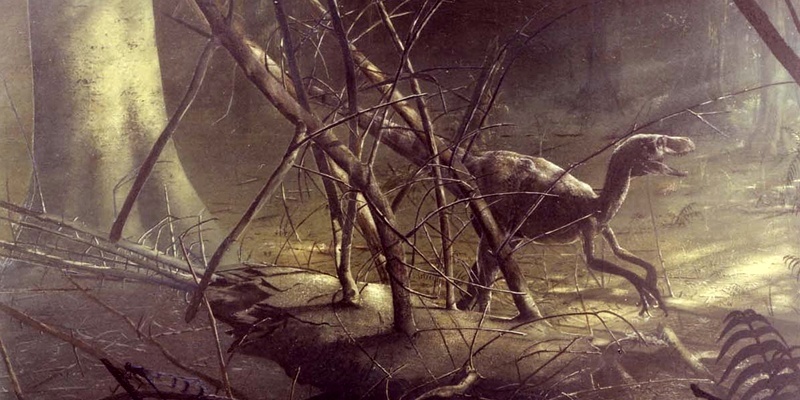Perth artist Jon Hoad specialises in depicting prehistoric life, and his images of dinosaurs have been on display in museums and exhibitions across the world. He tells Jennifer Cosgrove more about what it’s like to be a paleo-artist.
Jon said, “I took one look and it was like a religious experience. I thought to myself ‘that is what I want to do’. It wasn’t the dinosaur that excited me and I like dinosaurs it was actually the plants.
“Bizarrely, years later, the artist who painted that picture is a very close friend of mine.”
Jon was determined to create art like the kind he had seen in the magazine and decided to cut down on his freelance work and dedicate his time to learning about reconstructing prehistory.
“My way of looking at it was somebody has to do it and why can’t it be me? Back then, there was no internet and there was always a way of thinking these things only happened in places like America. I just locked myself away and got on with it.”
His work was first shown at Barrack Street Museum in Dundee and from there it came to the attention of a number of experts leading to greater exposure throughout the UK.
He has since produced work for The Dinosaur Society UK and Prehistoric Times magazine. Originals and prints of his work have also been on display in the UK, Europe, Asia and Australia.
Jon’s work also earned him a distinguished talent visa to live and work permanently in Australia, which he did for a number of years. He did work in schools out there, something he would like to do in Perthshire.
“I can go to schools and talk about earth history and evolution and try to better their understanding of time and geology. Then, of course, I’d help them create their own dinosaurs with my workshop called Draw-a-saur.”
He also teaches art classes at the Jardine Gallery in Perth for all ages and ability levels.
Jon opened the DinoMites exhibition at Sensation in Dundee with a talk for youngsters about his art and about the prehistoric world. The show gives an insight into baby and juvenile dinosaurs such as tyrannosaurus rex, triceratops and velociraptor and explores the life story of the species.
“I don’t think I’ve ever met any children who haven’t had an interest in dinosaurs. I think it’s just a natural curiosity,” he says.
“As we learn more about them, instead of somehow taking away the magic, it makes them even more incredible especially when you hear how big some of them were.”
“He added, The point about dinosaurs is they were so successful at being dinosaurs that nothing else really got a look in for almost 200 million years.
“You hear these comments about how dinosaurs must have failed because they were extinct, but we’ve only been here for five million years!”
DinoMites: The A to Z of Dinosaurs runs at Sensation Science Centre Dundee until September 30. See Jon’s website here.
“When dinosaurs first evolved, there was no grass and there were no oak trees or beech trees flowering plants at all. Dinosaurs evolved alongside the plants,” Jon tells me.
He’s full of interesting knowledge about plant life in prehistoric times, because he’s been studying it so closely for his art.
“I just love the chaos of plants and the way they grow. Paleo-botany which is the study of prehistoric flora was the hardest thing for me to get my head around and the thing that even to this day I spend my time getting to grips with.”
Jon’s business is called Art Of Ancient Life and he prides himself of checking every aspect of his pictures with fossil records to ensure the plants and insect life correspond to the time the dinosaur was in existence.
He said, “It’s important when you’re reconstructing prehistory because if you don’t know where a creature comes from then you have no clear idea how it interacted with its environment.
“I really want to put the effort into environments because if you don’t have a context for something it’s not going to be very valuable and you can’t tell much about it.”
He added, “Plants are the hardest thing to draw. A lot of people draw dinosaurs and they are very interesting. I am interested in salamanders and lizards and a lot of people have spent a lot of time reconstructing dinosaurs, so knowing where the muscles go is just a matter of doing research.
“I’m very cautious with colour, I don’t like things to be too garish. I’m not a fan of all teeth and claws and red stripes.”
Born in London, Jon (45) moved with his family to Perth while he was at primary school. As a boy, his dad took him fossil collecting in places like Lyme Regis in Dorset.
Jon’s interest in prehistory stems from watching the 1970s David Attenborough television series Life On Earth, which he describes as “probably the first proper natural history documentary.”
“It made you aware everything that’s alive now is firmly linked to what has been alive in the past and it showed some nice examples of that.”
At Perth High School, he loved to draw and is grateful to his “amazing” art teacher Ian Ross.
After school Jon took a graphic design course at Dundee College and soon after found a job with the Archaeological Trust in Perth producing reconstructions of human prehistory and habitation in Perthshire.
From there on Jon turned freelance, doing technical drawings for companies such as Black and Decker as well as designing logos and producing artwork for album sleeves.
He describes his work for the Archaeological Trust as incredibly useful because it gave him the skills he needed to approach this kind of work.
One day he stumbled upon an article in Scientific American magazine about Australian polar dinosaurs and saw an illustration that caught his eye.
Continued…
